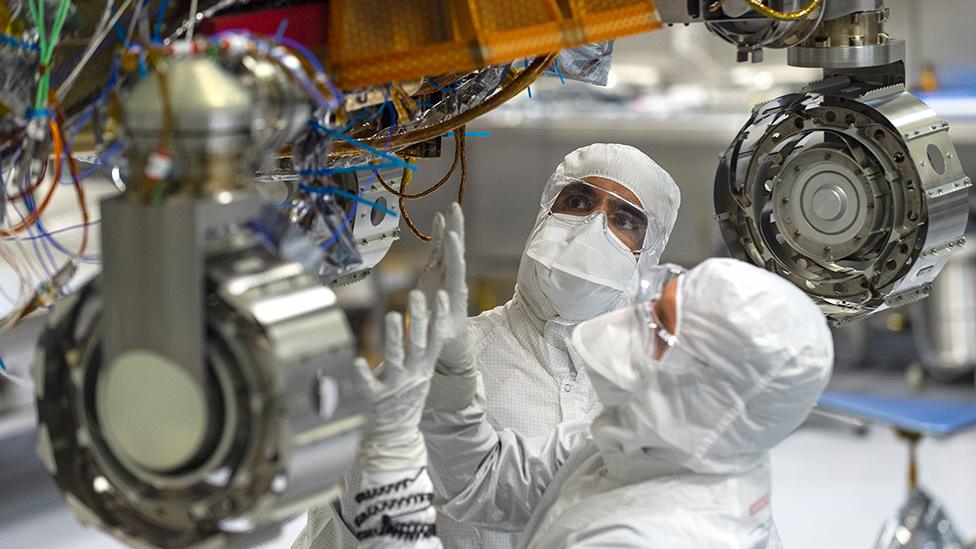Joint Europe-Russia Mars rover project is parked
- Published

Artist's impression: The robot rover is designed to search for life on Mars
The decision has been made. Europe's Mars rover will not be flying to the Red Planet this year.
Member states of the European Space Agency (Esa) formally voted on Thursday to suspend the joint mission with the Russians because of the war in Ukraine.
It'll create a huge technical headache, but Esa Council delegates felt there was no alternative.
The rover, assembled in the UK and named Rosalind Franklin, will be stored until a way to get it to Mars is found.
There are a wide range of possible options - from waiting until international relations and cooperation with the Russian space agency Roscosmos can be restarted to looking for other partners who can provide the technologies Europe is missing, in particular the US.
At this stage nothing is ruled in or out, but, realistically, the suspension will now delay the mission for many years.
"The decision was made that this launch cannot happen, given the current circumstances and especially the sanctions that are imposed by our member states," said agency director general Josef Aschbacher.
"This makes it practically impossible, but also politically impossible to have a launch of [the rover] in September."

The rover project was first approved in 2005
One of the difficulties is the narrowness of possible windows to launch to Mars.
This is governed by the alignment of the planets.
A mission typically gets a couple of weeks every 26 months when the positions are favourable. If the window is missed, a project must stand down for two years.
Esa Council's decision now means Rosalind Franklin won't launch until late 2024 at the earliest. And the half year it takes to cruise between the planets means a landing won't occur until mid-2025, again at the earliest.
Rosalind Franklin is the second stage in a two-part space programme with Russia known formally as ExoMars.
The first part is a satellite that was launched to the Red Planet in 2016. It is studying the planet's atmosphere and was due to act as a telecommunications relay platform for Rosalind Franklin when it arrived.
All elements of the rover mission are essentially built and ready to go. If there were no war in Ukraine, it would be launching on a Russian rocket, being shepherded to Mars by a German-built spacecraft, and then placed on the surface of the Red Planet by a Russian landing mechanism.
The suspension has left Esa looking potentially for a new rocket and a new lander.
Another non-Russian rocket could be found to launch the robot in 2024, but sourcing Western hardware to place the vehicle on the surface of the planet would not be so straightforward.
The expertise exists in Europe - and especially in the US - to build such a descent and landing system, but it would almost certainly take more than two years to design, build and test, meaning Rosalind Franklin will probably not get to a launch pad before 2026, perhaps not even until 2028.

Some components will need to be replaced
Esa Council was informed that there were no showstoppers in terms of storing either the shepherding spacecraft or the rover.
"We've had a first reflection and it is judged feasible for the rest of this decade to have the hardware ready to fly," said David Parker, the Esa director for human spaceflight and robotics.
"Yes, there will be periodic refurbishment and maintenance, particularly the ultra-clean laboratory in the rover. Maybe some components will become obsolete; there are some valves that isolate the laboratory; the battery will probably need replacing or maybe some mechanisms that are integrated into the laboratory that require lubrication.
"But the first assessment is that it's feasible," he told BBC News.
Council has asked industry to look at all the options and to cost them for future consideration.
The science of Rosalind Franklin will remain compelling throughout this decade. The robot was designed to drill 2m into the ground to look for signs of life. There is no other mission on the cards that plans to do this.
Whatever the solution, it will involve extra cost for a venture that has already posted a price tag in excess of €1bn (on the European side; Russian spending is unknown). The UK alone has invested more than €300m (£250m), with most of this money geared to the production of the rover.
